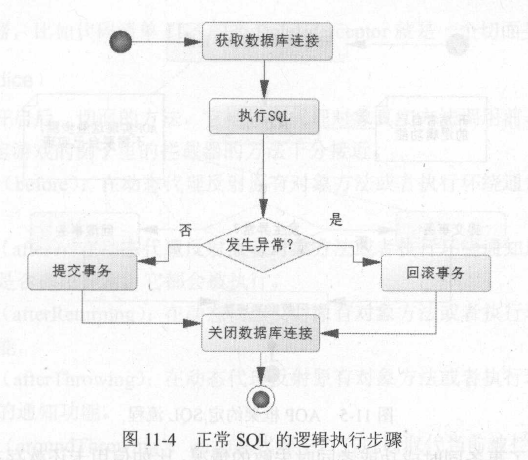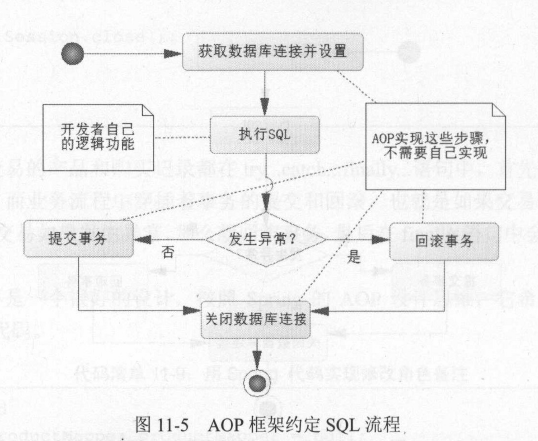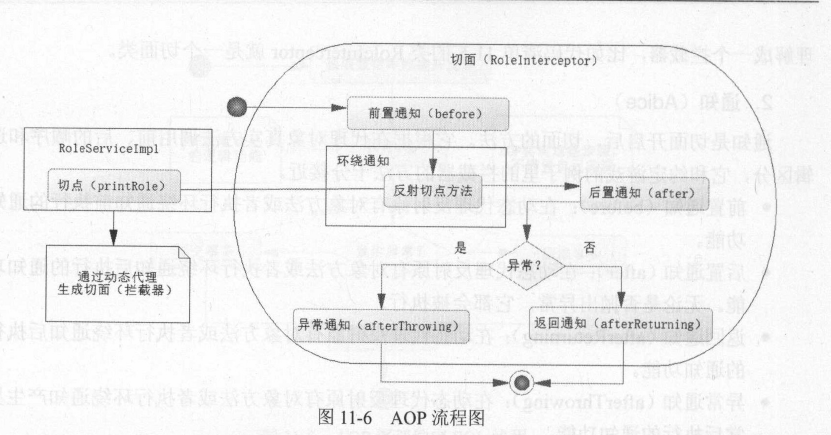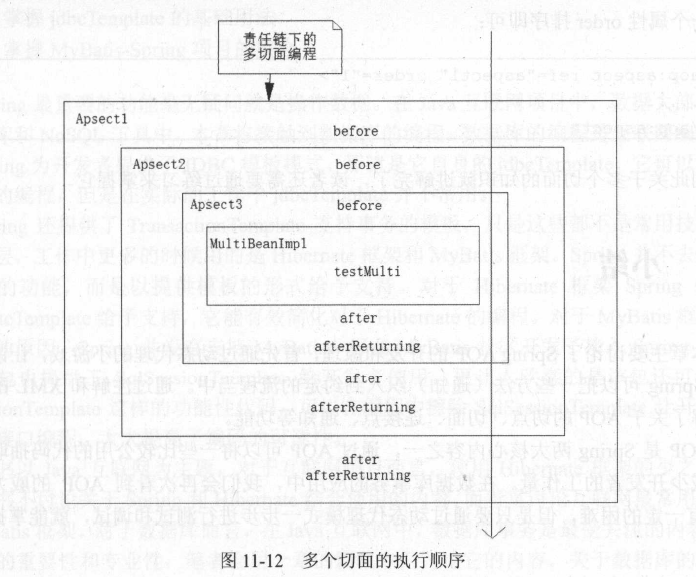第 11 章 面向切面编程
11.1 一个简单的约定游戏
略
11.2 SpringAOP的基本概念
11.2.1 AOP的概念和使用原因
先看一个不使用SpringAOP的例子,这里使用MyBatis框架,完成扣减一个产品的库存并且新增一笔交易记录的功能
1 | public void savePurchaseRecord(Long productId, PurchaseRecord record){ |
- 这里的购买交易的产品和购买记录都在
try...catch...finally...语句中 - 业务流程中穿插着事务的提交和回滚
- 并不是一个很好的设计
针对上一个例子的缺点,SpringAOP希望开发者能写成下面例子的代码
1 |
|
- 这段代码除了一个注解
@Transactional,没有任何打开、关闭数据库资源或者提交回滚事务的代码,却能完成与上面例子相同的功能 - 这段代码主要集中在业务处理上,而不是数据库事务和资源控制,这就是
AOP的魅力
接下来我们探讨SpringAOP是如何做到这点的。
AOP可以通过动态代理模式,带来管控各个对象操作的切面环境,管理包括日志、数据库事务等操作,让我们拥有在反射原有对象方法之前、正常返回之后、异常返回之后插入自己代码的能力,有时我们甚至可以取代原有对象方法。
下面还是以数据库事务的例子来做说明
-
首先我们来了解以下正常
SQL的逻辑步骤- 通过数据库连接池来获得数据库连接资源,并进行一定的设置工作
- 执行对应的
SQL语句,对数据进行操作 - 如果
SQL执行过程中发生异常,回滚事务 - 如果
SQL执行过程中没有发生异常,最后提交事务 - 关闭连接资源
-
SQL逻辑步骤的流程图如下

-
而作为
AOP,完全可以根据这个流程做一定的封装,然后通过动态代理技术,将代码织入到对应的流程中,我们完全可以进行如下设计- 打开获取数据连接在
before方法中完成 - 执行
SQL,通过反射机制调用业务逻辑 - 如果
SQL执行过程中发生异常,回滚事务,如果SQL执行过程中没有发生异常,提交事务,关闭连接资源
- 打开获取数据连接在
-
更重要的,对于数据库事务这种通用的操作来说,
SpringAOP已经提供了一些通用的拦截器来处理,并不需要开发者自己实现。开发者只需要修改配置,就可以定制想要的功能。这就是@Transactional标签要做的,当方法标注为@Transcational标签时,方法启用数据库事务功能。如下图所示

-
通过这种方式,达成了约定优于配置的原则,使得开发者更关注于业务逻辑本身,而不是资源的控制。
11.2.2 面向切面编程的术语
这一节来解释一些AOP的常用术语
1. 切面
切面就是在一个怎么样的环境中工作,它可以定义后面需要介绍的通知、切点和引入等内容,然后SpringAOP会将其定义的内容织入到约定的流程中,在动态代理中可以把它理解为拦截器,比如类RoleInterceptor就是一个切面类。而常见的比如说,数据库事务就可以理解为一个切面
2 通知
通知是切面的方法,与动态代理中,拦截器的方法类似,通知有如下种类:
- 前置通知(
before): 在动态代理反射原有对象方法前执行的通知 - 后置通知(
after): 在动态代理反射原有对象方法后执行的通知 - 返回通知(
afterRuturning):在动态代理反射原有对象方法正常返回后执行的通知 - 异常通知(
afterThrowing):在动态代理反射原有对象方法产生异常后执行的通知 - 环绕通知(
around):它可以取代当前被拦截对象的方法
3 引入
引入允许我们在现有的类里添加自定义的类和方法
4 切点
用来告诉SpringAOP在什么时候启动拦截并织入对应的流程中
5 连接点
连接点就是需要拦截器拦截的方法,比如例子中的savePurchaseRecord就是一个连接点
6 织入
织入是一个生成代理对象并将切面内容放入到流程中的过程
AOP的流程图如下所示

11.2.3 Spring对AOP的支持
SpringAOP是一种基于方法拦截的AOP。在Spring中有4种方法去实现AOP的拦截
- 使用
ProxyFactoryBean和对应的接口实现AOP - 使用
XML配置AOP - 使用
@AspectJ注解驱动切面 - 使用
AspectJ注入切面
11.3 使用@AspectJ注解开发SpringAOP
11.3.1 选择连接点
Spring是方法级别的AOP框架,所以连接点只能是某个类下的某个方法。用动态代理来理解,就是要拦截哪个方法织入对应的AOP通知。
例子:我们先定义一个接口,和一个实现类,然后将实现类里的方法作为连接点
1 | package ComponentDemo; |
1 | package ComponentDemo; |
11.3.2 创建切面
在Spring中使用@Aspect注解一个类,那么这个类就会被看作切面,就相当于动态代理中的拦截器类
1 | package ComponentDemo; |
11.3.3 定义切点
毕竟不是所有方法都需要使用AOP编程,所以我们的程序要有判断是否启用切面的功能,这也就是切点的定义,确定对于哪些调用启用切面。
如上面的例程所示,Spring是通过@Before这类注解后的正则表达式来判断切点的,例如下面这个表达式execution(* ComponentDemo.RoleServiceImpl.printRoleInfo(..))
execution: 表示执行方法的时候触发*:代表任意返回类型的方法ComponentDemo.RoleServiceImpl: 代表类的全限定名printRoleInfo: 是被拦截的方法名称(..): 任意的参数
进一步讨论这个正则表达式,它还可以配置如下内容
| AspectJ | 描述 |
|---|---|
arg() |
规定连接点匹配参数为指定类型的方法 |
@args() |
规定连接点匹配指定注解标注的方法 |
execution |
匹配连接点的执行方法 |
this() |
规定连接点匹配AOP代理的Bean |
target |
规定连接点匹配被代理对象为指定的类型 |
@target() |
规定连接点匹配特定的执行对象,这些对象要符合指定的注解类型 |
within() |
规定连接点匹配指定的包 |
@within() |
规定连接点匹配指定的类型 |
@annotation |
规定匹配带有指定注解的连接点 |
11.3.4 测试AOP
这一节来编写程序测试AOP是否生效
首先需要进行Spring Bean的配置
1 | package ComponentDemo; |
@EnableAspectJAutoProxy代表启用AspectJ框架的自动代理,这时Spring才会生成动态代理对象,进而使用AOP
然后编写程序的主入口即可
1 | package ComponentDemo; |
运行结果如下
1 | before...... |
11.3.5 环绕通知
环绕通知是SpringAOP中最强大的通知,它可以同时实现前置通知和后置通知。它保留了调度被代理对象原有方法的功能,所以它既强大,又灵活。但是由于强大,它的可控制性不那么强,如果不需要大量改变业务逻辑,一般而言并不需要使用它。
例如
1 | ("execution(* ComponentDemo.RoleServiceImpl.printRoleInfo(..))") |
11.3.6 织入
织入是生成代理对象并将切面内容放入约定流程的过程。使用JDK动态代理时,必须拥有接口,而使用CGLib 则不需要,于是Spring就提供了一个规则:当类的实现存在接口的时候,Spring将提供JDK动态代理。而当类不存在接口的时候没有办法使用JDK动态代理,Spring会采用CGLIB来生成代理对象。
11.3.7 给通知传递参数
有时我们希望给各类通知传递参数,可以使用如下方法
1 | ("execution(* ComponentDemo.RoleServiceImpl.printRoleInfo(..))" + "&& args(role)") |
- 在切点的表达式中,加入了参数的定义,这样便可以传递参数
11.3.8 引入
略
11.4 使用XML配置开发SpringAOP
方法大致和使用注解类似,这里不详细说明
11.5 经典SpringAOP应用程序
略
11.6 多个切面
Spring支持使多个切面按照指定的顺序运行,这时候可以使用注解@Order
1 |
|
1 |
|
1 |
|
Spring底层是通过责任链来处理多个切面的,如下图

11.7 小结
AOP是Spring两大核心内容之一,通过AOP可以将一些比较公用的代码抽取出来,进而减少开发者的工作量
